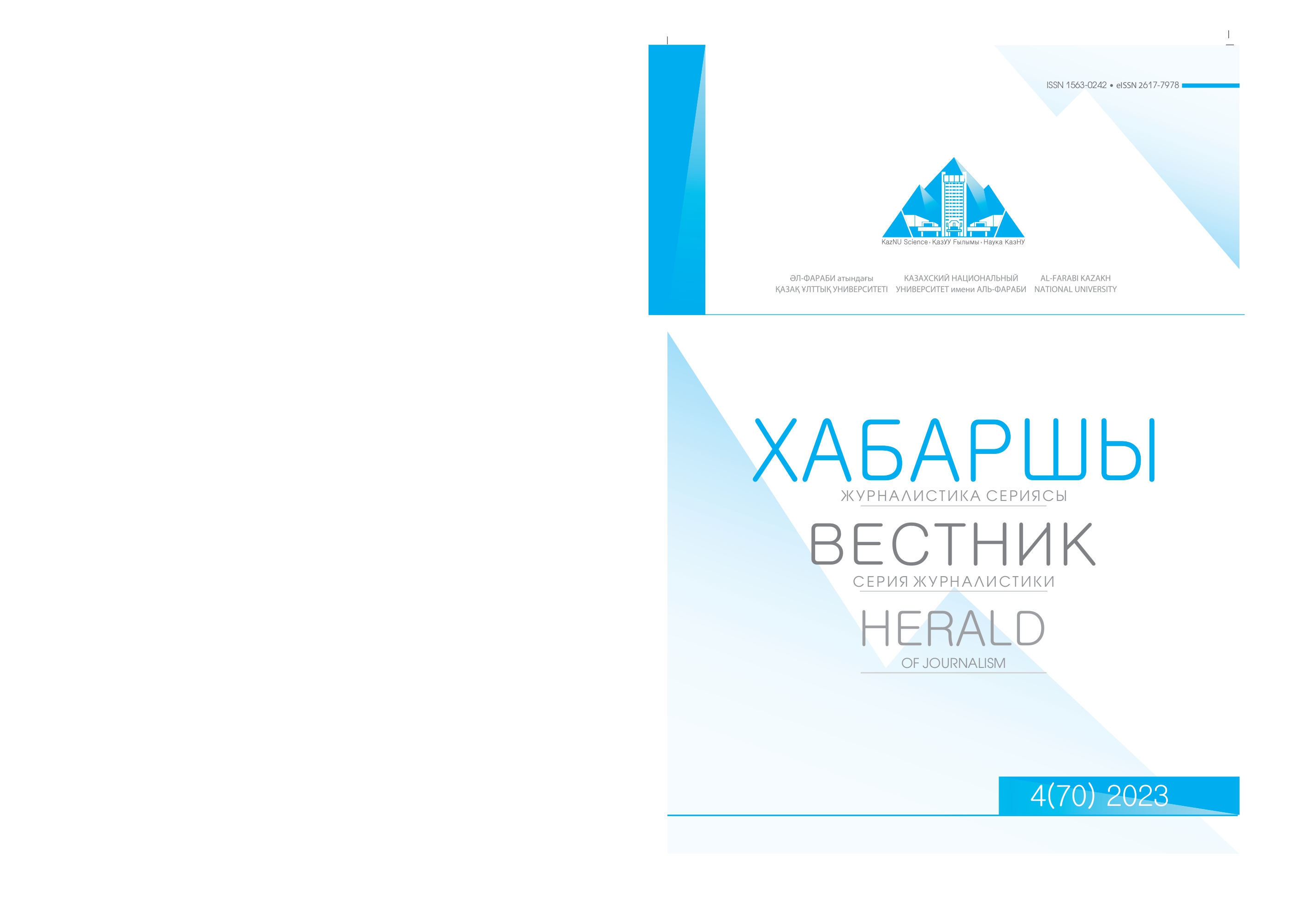MEDIA COVERAGE OF SOCIAL CONFLICTS IN THE KAZAKH MEDIA: A CASE STUDY OF AZATTYQ.ORG
DOI:
https://doi.org/10.26577/HJ.2023.v70.i4.5Keywords:
Keywords: conflict, interethnic conflicts, interethnic environment, Kazakhization, demonstration, media.Abstract
This research examines the realm of interethnic conflicts and their repercussions on social cohesion and stability within polyethnic societies. It places a significant emphasis on the crucial role that mass media, particularly the online platform Azattyq.org, plays in shaping public understanding, perception, and potential responses to such conflicts.
The primary objective of the study is to ensure accuracy and proper framing in the coverage of interethnic conflicts in Kazakhstan by analyzing media, specifically focusing on Azattyq.org. The research aims to identify key directions of analysis, including the structure, narratives, and perspectives employed by the media.
The significance of this work lies in examining the role of Kazakhstani media, particularly Azattyq.org, in disseminating information about interethnic conflicts. Despite being a vital channel for information dissemination, there is an evident gap in the comprehensive coverage of many ethnic issues. Given that citizens often rely on media reports to shape their understanding of interethnic dynamics, scrutinizing their methods, especially in Kazakhstan's diverse and multicultural context, becomes imperative.
Qualitative methods are employed, using Azattyq.org as a case study to analyze the coverage of interethnic conflicts in the media. Thematic analysis is utilized to identify recurring patterns, frames, and discourses related to interethnic conflicts.
Key findings reveal that Azattyq.org often maintains an objective tone, incorporates expert opinions, and contextualizes events politically in its coverage of interethnic events. Detailed descriptions of specific interethnic conflicts from 2006 to 2019 shed light on the complexities and nuances of these tensions in Kazakhstan.
Conclusions drawn from the research underscore the importance of responsible journalism in mitigating xenophobia and nationalism. The study contributes to the field by providing a nuanced understanding of how interethnic conflicts are reflected in Kazakhstani media, particularly on Azattyq.org.
Practically, the results are valuable for media practices, guiding journalists and media organizations toward responsible coverage of interethnic conflicts. By revealing the intricacies of narrative construction and contextualization within political frameworks, the research offers recommendations for fostering a more conscious and tolerant public dialogue, contributing to social harmony and understanding.
References
References:
Aksholakova, A., & Ismailova, N. (2013). The Language Policy of Kazakhstan and the State Language in Government Service. Procedia - Social and Behavioral Sciences, 93, 1580-1581.
Brooks, B. S., Kennedy, G., Moen, D. R., & Ranly, D. (The Missouri group). (1999). News reporting and writing (6th ed.).
Entman, R. (2000). Declaration of Independence: The Growth of the Media after the Cold War. In B. Nacos, R. Shapiro, & P. Isernia (Eds.), Decision Making in a Glass House (pp. 4). Lanham: Rowman & Littlefield.
Huntington, S. P. (1993). The Clash of Civilizations? Vol. 72, No. 3, 22-49.
Kashkinbayev, А. T. (2019). Evaluation of the Role of Media and Language Policy in the Stabilization of Interethnic Relations at the Present Stage: The Example of a Multinational Kazakhstan
Lichbach, Almeida, P., & Mark. (2003). To the Internet, from the Internet: Comparative Media Coverage of Transnational Protests. Mobilization, 8(3), 249-272.
Mozingo, D. M. (2015). An Analysis of the Factors that Influence Ethnic Conflict and Minority Violence in the Western Balkans (pp. 9-10).
Muminova, F. (2002). National Identity, National Mentality, and the Media. Central Asia and the Caucasus, 5(17).
Peake, J. (2001). Presidential Agenda Setting in Foreign Policy. Political Research Quarterly, 54(1), 69–86.
Ryan, M. (2001). Journalistic Ethics, Objectivity, Existential Journalism, Standpoint Epistemology, and Public Journalism. Journal of Mass Media Ethics, 16(1), 3-22.
Stoker, K. (1995). Existential Objectivity: Freeing Journalists to be Ethical. Journal of Mass Media Ethics, 10, 5–22.
Tajfel, H., & Turner, J. C. (1979). An Integrative Theory of Intergroup Conflict. In W. G. Austin & S. Worchel (Eds.), The Social Psychology of Intergroup Relations (pp. 33-37).
Surucu, C. (2002). Western in Form: Eastern in Content: Negotiating Time and Space in Post-Soviet Kazakhstan (paper presented at the TOSCCA workshop “Kazakhstan”).
Tussupova, D. (2010). Mass Media and Ethnic Relations in Kazakhstan. Problems of Post-Communism, 57(6), 32-45.
Electronic Resources:
https://www.azattyq.org/a/1176904.html
https://rus.azattyq.org/a/the-kazakh-authorities-do-not-recognize-ethnic-conflicts-/31001861.html
https://www.azattyq.org/a/kazakhstan-press-review-ethnic-clashes-nazarbayev-grandson/30435696.html
https://www.azattyq.org/a/1176904.html
https://www.azattyq.org/a/24497515.html
https://www.azattyq.org/a/27976977.html
https://www.azattyq.org/a/kazakhstan-kordai-clash/30428384.html
https://cabar.asia/ru/eksperty-v-kazahstane-zakryvayut-glaza-na-mezhetnicheskie-konflikty
https://www.caravan.kz/articles/o-voprosakh-zhurnalistskojj-ehtiki-372829/




